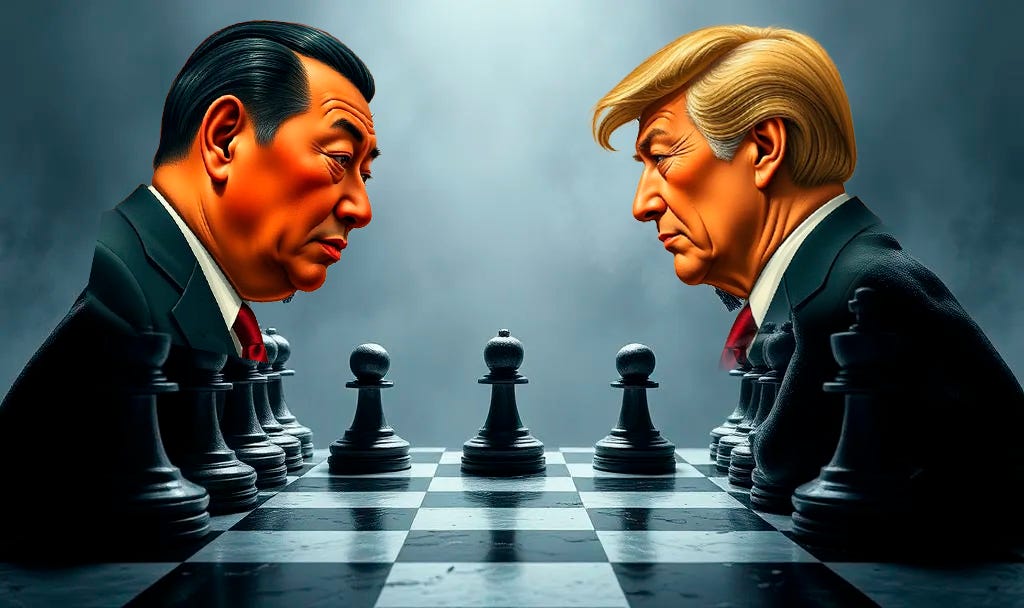UPDATE: Trade War in Real Time—China and the U.S. Enter the Age of Mutual Lockout
Trump’s 90-day tariff delay changes little. Supply chains are fracturing, tech bans are escalating, and consumers pay the price.
Preface
While our earlier piece examined the historical and structural dangers of economic warfare, the numbers are already shifting.
Fellow readers, I don’t make the headlines—I examine them. And in a world full of shifting narratives and moving targets, I aim to get to the heart of the matter: how does it impact us, and what does it really mean? Let’s be clear—in this scenario, one side is lying while the other is standing their ground. One side is the bully; the other is defending itself. The claim that China will “pay” a 145% tariff is misleading. The truth? American citizens will foot the bill. That tariff just means a 145%1 increase in the cost of the product. And even items not labeled "Made in China" will feel the ripple effect—because so many products start in China, especially since the West outsourced its polluting factories there. The crows have come home to roost.
This isn’t just about tariffs. It’s about two superpowers slamming doors—on semiconductors, rare earths, and even consumer trust. The 90-day ‘pause’ on the rest of the world is a tactical feint. The decoupling? It’s live.
We’re Not Backtracking. We’re Just Hitting ‘Pause.’
As of the press time, April 16, 2025, in a move signaling to some strategic hesitation to others chaotic madness, Trump announced a 90-day delay on new tariffs—possibly to ease market panic, manipulate the market, or to give Beijing an offramp. Whether Trump is saving face, yielding to behind-the-scenes pressure, or behaving like a madman—remains to be seen.
But make no mistake: the underlying trajectory hasn’t changed. U.S. tariffs on China still stand at historically high levels—and China’s retaliation remains aggressive. Some Chinese companies are already shut out of U.S. markets, and the same is true in reverse.
At this point, what we’re seeing isn’t just a tariff tit-for-tat. It's a slow-motion severing of access:
Chinese companies are being de-listed, sanctioned, or denied federal contracts.
U.S. firms face increased inspections, regulatory blockades, and propaganda-fueled consumer backlash in China.
High-tech goods—semiconductors, EVs, biotech inputs—are the first casualties.
The LBJ interview opens with Victor Gao of the Center for China and Globalization, followed by additional commentary—together framing the trade war as a nationalist struggle rooted in identity, sovereignty, and ideology. It’s not just about economics—it’s about identity, sovereignty, and ideology. In short, they surmise: there’s no easy walk-back.
"The world is big enough that the United States is not the totality of the world" - Victor Gao
China has emphatically stated that it does not fear the United States' tariffs and will not back down. This isn't a game of bluff—it’s a game of consequences, and it's Americans who will feel the sting at the checkout line.
LOCKOUT ECONOMICS: WHEN BOTH SIDES SHUT THE DOOR
U.S. → China: Tariffs + export controls
China → U.S.: Tech bans + rare earth embargo threats + consumer nationalism
Let’s take a closer look:
U.S. Lockouts on China:
Tech: Bans on AI chips, quantum computing exports.
Finance: Delisting of Chinese firms (NYSE: 12 and counting).
Defense: Sanctions on 37 new entities (April 2025).
China’s Retaliation:
Critical Minerals: Rare earth export permits slowed by 68% (Q1 2025).
Consumer Nationalism: "Buy Chinese" campaigns hit Apple, Tesla sales.
Regulatory Siege: U.S. pharma now faces 6-month approval delays.
Result? A new Cold War, a supply-chain cold war where battles are fought in boardrooms and the stock market, not in trenches. However, the casualties are still just as bloodied.
Even with the 90-day hold, we’re already watching a decoupling of historic scale. Businesses on both sides are rushing to “de-risk,” diversify supply chains, and retool entire operations.
But that’s not fast—and it’s definitely not cheap.
What to Watch Next:
Three Flashpoints to Track Before July
Tech Supply Chains: Can Intel/Micron replace banned Chinese chips fast enough?
Rare Earths: If China throttles exports, does Australia’s Lynas Corp have capacity?
Consumer Backlash: Will Beijing escalate boycotts (e.g., Starbucks, Nike)?
Final Thought
The 90-day pause is a comma, not a period. For businesses and consumers, the sentence reads: Adapt or bleed.
Even with cooler heads temporarily prevailing, the global trade order as we knew it is fracturing. Tariffs are just the opening move. What comes next may be harder to reverse.
#StayWoke
As of the completion of this article the United States imposed a 145% tariff on China and China imposed a %125 tariff on the United States.



